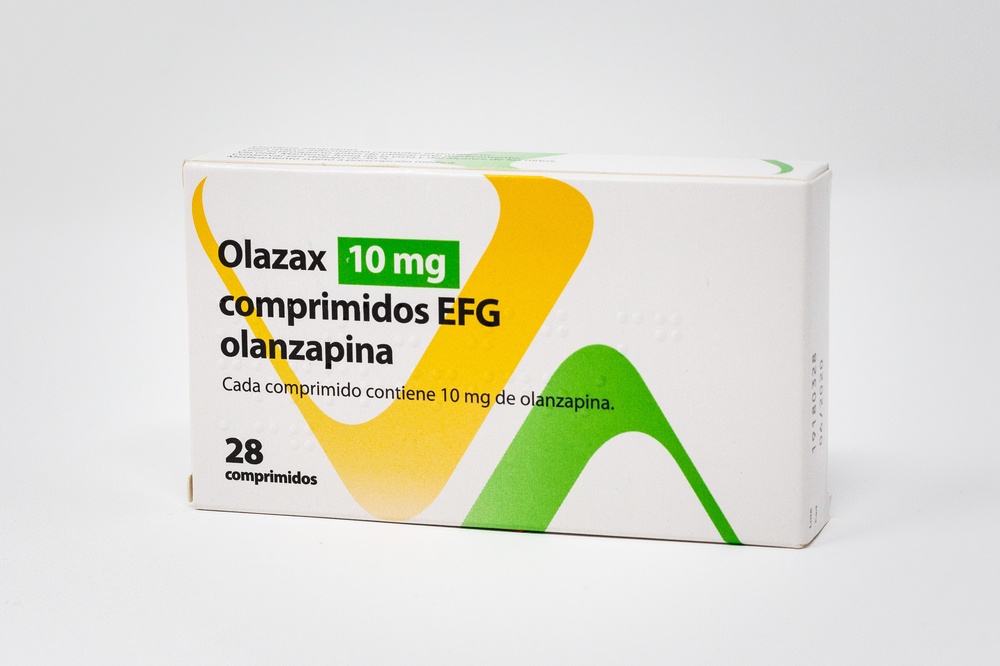

OLAZAX 10 mg COMPRIMIDOS

Pergunte a um médico sobre a prescrição de OLAZAX 10 mg COMPRIMIDOS

Como usar OLAZAX 10 mg COMPRIMIDOS
Introdução
Prospecto: informação para o utilizador
Olazax 5 mg comprimidos EFG
Olazax 7,5 mg comprimidos EFG
Olazax 10 mg comprimidos EFG
Olazax 15 mg comprimidos EFG
Olazax 20 mg comprimidos EFG
Olanzapina
Leia todo o prospecto detenidamente antes de começar a tomar este medicamento, porque contém informações importantes para si.
- Conserva este prospecto, porque pode ter que voltar a lê-lo.
- Se tiver alguma dúvida, consulte o seu médico ou farmacêutico.
- Este medicamento foi prescrito para si e não deve dá-lo a outras pessoas, mesmo que tenham os mesmos sintomas que si, porque pode prejudicá-las.
- Se experimentar efeitos adversos, consulte o seu médico ou farmacêutico, mesmo que se trate de efeitos adversos que não aparecem neste prospecto. Ver secção 4.
Conteúdo do prospecto:
- O que é Olazax e para que é utilizado
- O que necessita saber antes de começar a tomar Olazax
- Como tomar Olazax
- Possíveis efeitos adversos
- Conservação de Olazax
- Conteúdo do envase e informação adicional
1. O que é Olazax e para que é utilizado
Olazax contém o princípio ativo olanzapina. Olazax pertence ao grupo de medicamentos denominados antipsicóticos e está indicado para tratar as seguintes doenças:
- Esquizofrenia, uma doença cujos sintomas são ouvir, ver ou sentir coisas irreais, crenças erróneas, suspeita incomum, e tornar-se retraído. As pessoas que sofrem dessas doenças podem encontrar-se, além disso, deprimidas, com ansiedade ou tensas.
- Trastorno maníaco de moderado a grave, caracterizado por sintomas tais como excitação ou euforia.
OLAZAX demonstrou prevenir a recorrência desses sintomas em pacientes com trastorno bipolar cujos episódios maníacos responderam ao tratamento com olanzapina.
2. O que necessita saber antes de começar a tomar OLAZAX
Não tome Olazax
- Se é alérgico à olanzapina ou a qualquer um dos outros componentes deste medicamento (incluídos na secção 6). A reação alérgica pode manifestar-se em forma de erupção, picazão, inchação do rosto ou dos lábios ou dificuldade para respirar. Se lhe acontecer isso, diga-o ao seu médico.
- Se previamente lhe foi diagnosticado problemas nos olhos tais como certos tipos de glaucoma (aumento da pressão no olho).
Advertências e precauções
Consulte o seu médico ou farmacêutico antes de começar a tomar Olazax
- Não se recomenda o uso de Olazax em pacientes de idade avançada com demência, pois pode ter efeitos adversos graves.
- Medicamentos deste tipo podem provocar movimentos incomuns, sobretudo na face ou na língua. Se lhe acontecer isso após ter tomado Olazax, diga-o ao seu médico.
- Em muito raras ocasiões, medicamentos deste tipo produzem uma combinação de febre, respiração acelerada, suor, rigidez muscular e um estado de obnubilação ou sonolência. Se lhe acontecer isso, entre em contacto com o seu médico imediatamente.
- Verificou-se um aumento de peso nos pacientes que estão tomando Olazax. Si e o seu médico devem verificar o seu peso com regularidade. Se for necessário, o seu médico pode ajudá-lo a planificar uma dieta ou considerar a possibilidade de o remeter a um nutricionista.
- Verificaram-se níveis elevados de açúcar e gorduras (triglicéridos e colesterol) no sangue nos pacientes que estão tomando Olazax. O seu médico deve fazer-lhe análises de sangue para controlar o açúcar no sangue e os níveis de gordura antes de começar a tomar Olazax e de forma regular durante o tratamento.
- Se si ou alguém na sua família tem antecedentes de coágulos sanguíneos, consulte com o seu médico, pois os medicamentos deste tipo foram associados à formação de coágulos no sangue.
Se si padece alguma das seguintes doenças, diga-o ao seu médico o mais breve possível:
- Infarto cerebral ou falta de riego sanguíneo transitório no cérebro (sintomas passageiros de infarto cerebral).
- Doença de Parkinson
- Problemas de próstata
- Bloqueio intestinal (Íleo paralítico)
- Doença do fígado ou rim
- Alterações do sangue
- Doenças do coração
- Diabetes
- Convulsões
Se sofre demência, si ou o seu cuidador ou familiar devem informar o seu médico se já teve algum infarto cerebral ou falta de riego sanguíneo no cérebro.
Como precaução rotineira, se tiver mais de 65 anos, conviria que o seu médico o controlasse a tensão arterial.
Crianças e adolescentes
Os pacientes menores de 18 anos não devem tomar Olazax.
Uso de Olazax com outros medicamentos
Só use outros medicamentos ao mesmo tempo que Olazax, se o seu médico o autorizar. É possível que sinta certa sensação de sonolência se combinar Olazax com antidepressivos ou medicamentos para a ansiedade ou que ajudem a dormir (tranquilizantes).
Informa ao seu médico ou farmacêutico se está utilizando, utilizou recentemente
ou poderia ter que utilizar qualquer outro medicamento.
Em concreto, diga ao seu médico se está tomando:
- medicação para a doença de Parkinson
- carbamazepina (um antiepiléptico e estabilizador do humor), fluvoxamina (um antidepressivo) ou ciprofloxacino (um antibiótico). Pode que necessitem alterar a sua dose de Olazax.
Uso de Olazax com álcool
Não deve beber álcool se lhe foi administrado Olazax, porque pode produzir sonolência.
Gravidez e amamentação
Se está grávida ou em período de amamentação, acredita que possa estar grávida ou tem intenção de engravidar, consulte o seu médico antes de utilizar este medicamento. Não deve tomar este medicamento quando estiver a amamentar, pois pequenas quantidades de Olazax podem passar para o leite materno.
Podem produzir-se os seguintes sintomas em bebés recém-nascidos, de mães que foram tratadas com Olazax no último trimestre de gravidez (últimos três meses da sua gravidez): tremores, rigidez e/ou fraqueza muscular, sonolência, agitação, problemas ao respirar, e dificuldade na alimentação. Se o seu bebé desenvolver algum desses sintomas, entre em contacto com o seu médico.
Condução e uso de máquinas
Existe o risco de sofrer sonolência quando estiver tomando Olazax. Se lhe acontecer isso, não conduza veículos nem use máquinas. Consulter o seu médico.
Os comprimidos de Olazax contêm aspartamo, que é uma fonte de fenilalanina.Os comprimidos de Olanzapina Glenmark contêm aspartamo, que é uma fonte de fenilalanina. Por isso, este medicamento pode ser prejudicial para pessoas com fenilcetonúria.
3. Como tomar Olazax
Siga exatamente as instruções de administração deste medicamento indicadas pelo seu médico. Em caso de dúvida, consulte novamente o seu médico ou farmacêutico. Consulte o seu médico ou farmacêutico se tiver dúvidas.
O seu médico indicar-lhe-á quantos comprimidos de Olazax deve tomar e durante quanto tempo. A dose diária de Olazax oscila entre 5 mg e 20 mg. Consulte com o seu médico se voltar a sofrer os sintomas, mas não deixe de tomar Olazax a menos que o seu médico o diga.
Deve tomar os seus comprimidos de Olazax uma vez ao dia, seguindo as instruções do seu médico. Procure tomar os comprimidos à mesma hora todos os dias. Pode tomar os comprimidos com ou sem alimentos. Os comprimidos revestidos de Olazax são para administração via oral. Deve engolir os comprimidos de Olazax inteiros com água.
Se tomar mais Olazax do que deve
Os pacientes que tomaram mais Olazax do que deviam, experimentaram os seguintes sintomas: batimentos rápidos do coração, agitação/agressividade, problemas com a fala, movimentos incomuns (especialmente da face e da língua) e um nível reduzido de consciência. Outros sintomas podem ser: confusão aguda, convulsões (epilepsia), coma, uma combinação de febre, respiração rápida, suor, rigidez muscular, sonolência ou letargia, enlentecimento da frequência respiratória, aspiração, aumento da tensão arterial ou diminuição da tensão arterial, ritmos anormais do coração. Entre em contacto com o seu médico ou dirija-se imediatamente ao hospital se notar algum dos sintomas antes mencionados. Mostre ao médico o envase com os comprimidos.
Se esquecer de tomar Olazax
Tome os seus comprimidos assim que se lembrar. Não tome uma dose dupla para compensar as doses esquecidas.
Se interromper o tratamento com Olazax
Não interrompa o tratamento simplesmente porque note que se encontra melhor. É muito importante que continue a tomar Olazax enquanto o seu médico o disser.
Se deixar de tomar Olazax de forma repentina, podem aparecer sintomas como suor, impossibilidade para dormir, tremores, ansiedade, ou náuseas e vómitos. O seu médico pode sugerir-lhe que reduza a dose gradualmente antes de deixar o tratamento.
Se tiver alguma outra dúvida sobre o uso deste medicamento, pergunte ao seu médico ou farmacêutico.
4. Possíveis efeitos adversos
Como todos os medicamentos, este medicamento pode produzir efeitos adversos, embora nem todas as pessoas os sofram.
Entre em contacto imediatamente com o seu médico se si tiver:
?
- coágulos sanguíneos nas veias (um efeito adverso pouco frequente que pode afetar até 1 de cada 100 pessoas), especialmente nas pernas (os sintomas incluem suor, dor e vermelhidão na perna), que podem viajar através do sangue para os pulmões, causando dor no peito e dificuldade para respirar. Se experimentar algum desses sintomas, acuda ao médico imediatamente.
- combinação de febre, respiração acelerada, suor, rigidez muscular e um estado de obnubilação ou sonolência (a frequência não pode ser estimada a partir dos dados disponíveis)
Efeitos adversos muito frequentes (que podem afetar mais de 1 em cada 10 pessoas) incluem:
- Aumento de peso
- Sonolência
- Aumento dos níveis de prolactina no sangue
- Nas primeiras fases do tratamento, algumas pessoas podem sentir tonturas ou desmaios (com batimentos do coração mais lentos), sobretudo ao incorporar-se quando estão deitados ou sentados. Esta sensação costuma desaparecer espontaneamente, mas se não acontecer assim, consulte o seu médico.
Efeitos adversos frequentes (podem afetar até 1 de cada 10 pessoas) incluem:
- Mudanças nos níveis de algumas células sanguíneas, lípidos circulantes e, no início do tratamento, aumentos temporários das enzimas hepáticas.
- Aumento dos níveis de açúcar no sangue e na urina.
- Aumento dos níveis de ácido úrico e creatina fosfoquinase no sangue.
- Aumento do apetite.
- Tonturas.
- Agitação.
- Tremores.
- Movimentos extraños (discinesia).
- Alterações da linguagem.
- Constipação.
- Secura da boca.
- Erupção na pele.
- Perda de força.
- Cansaço excessivo.
- Febre
- Dor nas articulações
- Retenção de líquidos que provoca inflamação das mãos, dos tornozelos ou dos pés,
- Disfunções sexuais, tais como diminuição da libido em homens e mulheres ou disfunção eréctil em homens.
Efeitos adversos pouco frequentes (podem afetar até 1 pessoa em cada 100) incluem:
- Hipersensibilidade (p. ex. inflamação da boca e da garganta, picazão, erupção na pele)
- Diabetes ou piora do diabetes, relacionados ocasionalmente com cetoacidose (acetona no sangue e na urina) ou coma
- Convulsões, na maioria dos casos relacionadas com antecedentes de convulsões (epilepsia)
- Rigidez muscular ou espasmos (incluindo movimentos dos olhos)
- Síndrome de pernas inquietas
- Problemas com a fala
- gaguez
- Pulso lento.
- Sensibilidade à luz do sol.
- Sangramento pelo nariz
- Distensão abdominal
- Salivação excessiva
- Perda de memória ou esquecimento
- Incontinência urinária, perda da habilidade para urinar.
- Perda de cabelo.
- Ausência ou diminuição dos períodos menstruais.
- Mudanças na glândula mamária em homens e mulheres, tais como produção anormal de leite materno ou crescimento anormal.
Efeitos adversos raros (podem afetar até 1 pessoa em cada 1.000) incluem:
- Descida da temperatura corporal normal.
- Ritmo anormal do coração.
- Morte repentina sem explicação aparente.
- Inflamação do pâncreas, que provoca forte dor de estômago, febre e malestar.
- Doença do fígado, com aparecimento de coloração amarelada na pele e nas zonas brancas do olho.
- Trastorno muscular que se apresenta como dores sem explicação aparente.
- Ereção prolongada e/ou dolorosa.
Efeitos adversos muito raros (podem afetar até 1 de cada 10.000 pessoas) incluem:
- Reações alérgicas graves, como o Síndrome de Reação a Fármaco com Eosinofilia e Sintomas Sistémicos (DRESS) DRESS manifesta-se inicialmente com sintomas semelhantes aos da gripe, com erupção cutânea na face que se estende luego a outras zonas, febre, inchação dos gânglios linfáticos, níveis elevados de enzimas hepáticas nos análises de sangue e aumento de um tipo de glóbulos brancos (eosinofilia).
Durante o tratamento com olanzapina, os pacientes de idade avançada com demência podem sofrer acidentes vasculares cerebrais, pneumonia, incontinência urinária, quedas, cansaço extremo, alucinações visuais, uma subida da temperatura corporal, vermelhidão da pele e ter problemas ao caminhar. Foram notificados alguns óbitos neste grupo particular de pacientes.
Olazax pode piorar os sintomas em pacientes com doença de Parkinson.
Comunicação de efeitos adversos
Se experimentar qualquer tipo de efeito adverso, consulte o seu médico ou farmacêutico, mesmo que se trate de possíveis efeitos adversos que não aparecem neste prospecto. Também pode comunicá-los diretamente através do sistema nacional de notificação incluído no Anexo V. Mediante a comunicação de efeitos adversos, si pode contribuir para proporcionar mais informações sobre a segurança deste medicamento.
5. Conservação de OLAZAX
Mantenha fora da vista e do alcance das crianças.
Não utilize este medicamento após a data de validade que aparece no envase e no blister. A data de validade refere-se ao último dia do mês indicado.
Conservar por debaixo de 30 ºC.
Os medicamentos não devem ser jogados fora por meio dos esgotos nem pela lixeira. Pergunte ao seu farmacêutico como se livrar dos envases e dos medicamentos que já não precisa. Desta forma, ajudará a proteger o meio ambiente.
6. Conteúdo do envase e informação adicional
Composição de Olazax
- O princípio ativo é olanzapina.
- Cada comprimido de Olazax contém 5 mg, 7,5 mg, 10 mg, 15 mg, 20 mg de olanzapina.
- Os demais componentes são manitol (E 421), celulosa microcristalina, aspartamo (E 951), crospovidona e estearato de magnésio.
Aspecto de Olazax e conteúdo do envase
Olazax 5 mg:
comprimidos redondos de bordo plano biselado e cor amarela com uma "B" inscrita em uma face.
Olazax 7,5 mg:
comprimidos redondos de bordo plano biselado e cor amarela com uma "C" inscrita em uma face.
Olazax 10 mg:
comprimidos redondos de bordo plano biselado e cor amarela com "OL" inscrito em uma face e uma "D" inscrita na outra face.
Olazax 15 mg:
comprimidos redondos de bordo plano biselado e cor amarela com "OL" inscrito em uma face e uma "E" inscrita na outra face.
Olazax 20 mg:
comprimidos redondos de bordo plano biselado e cor amarela com "OL" inscrito em uma face e uma "F" inscrita na outra face.
Olazax, 5 mg, 7,5 mg, 10 mg, 15 mg, 20 mg é apresentado em blister de lâmina de alumínio de 28 & 56 comprimidos
Pode ser que apenas alguns tamanhos de envases estejam comercializados.
Titular da autorização de comercialização e responsável pela fabricação
Responsável pela comercialização
Glenmark Pharmaceuticals s.r.o. Hvezdova 1716/2b, 140 78 Praha 4 República Checa
Responsável pela fabricação Glenmark Pharmaceuticals s.r.o. Hvezdova 1716/2b, 140 78 Praha 4 República Checa
Data da última revisão deste prospecto:Maio 2020
A informação detalhada deste medicamento está disponível na página web da Agência Europeia de Medicamentos (EMA) http://www.emea.europa.eu

Quanto custa o OLAZAX 10 mg COMPRIMIDOS em Espanha em 2025?
O preço médio do OLAZAX 10 mg COMPRIMIDOS em dezembro de 2025 é de cerca de 105.78 EUR. Os valores podem variar consoante a região, a farmácia e a necessidade de receita. Confirme sempre com uma farmácia local ou fonte online para obter informações atualizadas.
- País de registo
- Preço médio em farmácia105.78 EUR
- Substância ativa
- Requer receita médicaSim
- Fabricante
- Esta informação é apenas para referência e não constitui aconselhamento médico. Consulte sempre um médico antes de tomar qualquer medicamento. A Oladoctor não se responsabiliza por decisões médicas baseadas neste conteúdo.
- Alternativas a OLAZAX 10 mg COMPRIMIDOSForma farmacêutica: COMPRIMIDO, 10 mgSubstância ativa: olanzapineFabricante: Neuraxpharm Spain S.L.Requer receita médicaForma farmacêutica: COMPRIMIDO, 2,5 mgSubstância ativa: olanzapineFabricante: Neuraxpharm Spain S.L.Requer receita médicaForma farmacêutica: COMPRIMIDO, 5 mgSubstância ativa: olanzapineFabricante: Neuraxpharm Spain S.L.Requer receita médica
Alternativas a OLAZAX 10 mg COMPRIMIDOS noutros países
As melhores alternativas com o mesmo princípio ativo e efeito terapêutico.
Alternativa a OLAZAX 10 mg COMPRIMIDOS em Polónia
Alternativa a OLAZAX 10 mg COMPRIMIDOS em Ukraine
Médicos online para OLAZAX 10 mg COMPRIMIDOS
Avaliação de posologia, efeitos secundários, interações, contraindicações e renovação da receita de OLAZAX 10 mg COMPRIMIDOS – sujeita a avaliação médica e regras locais.










